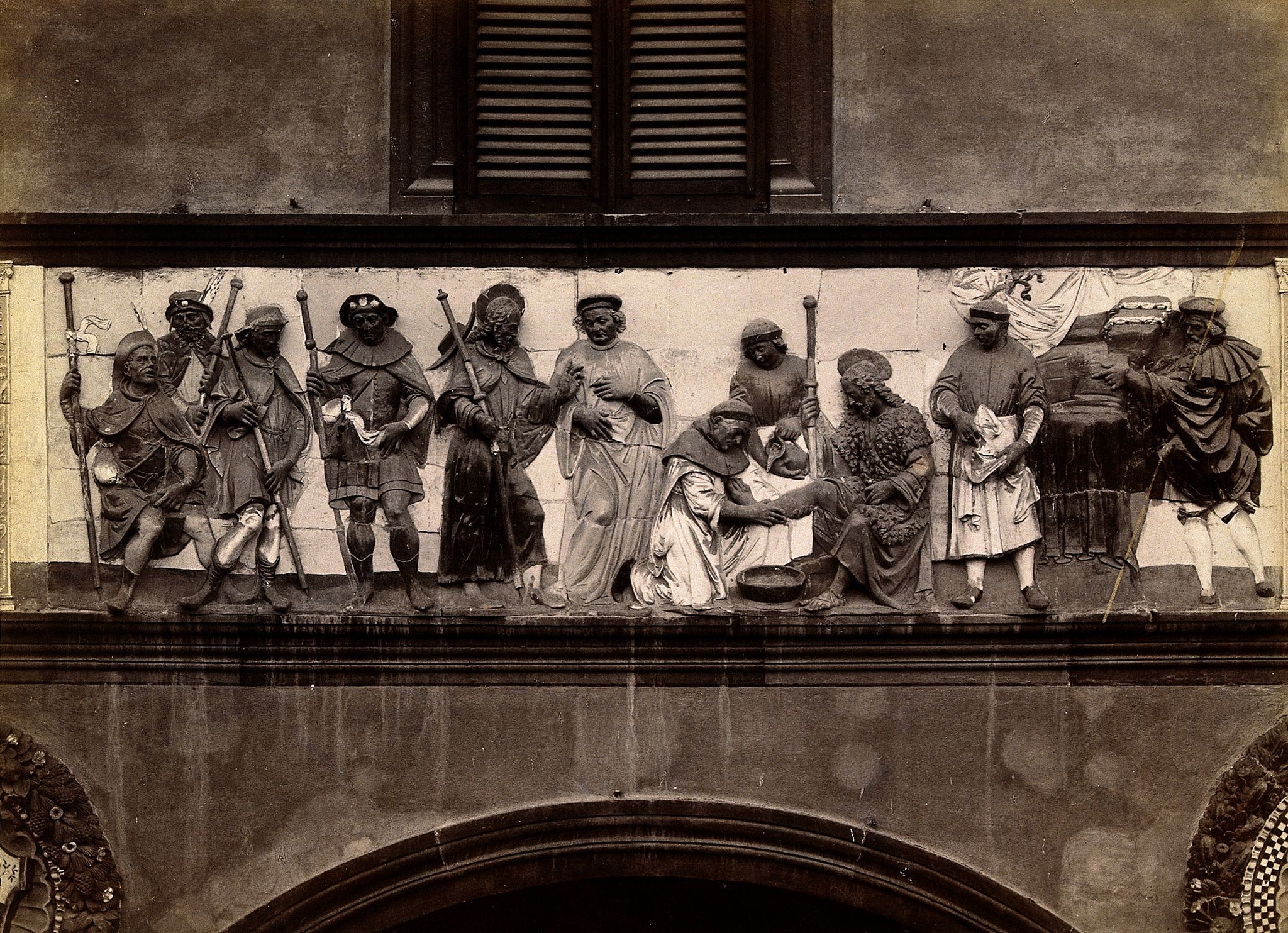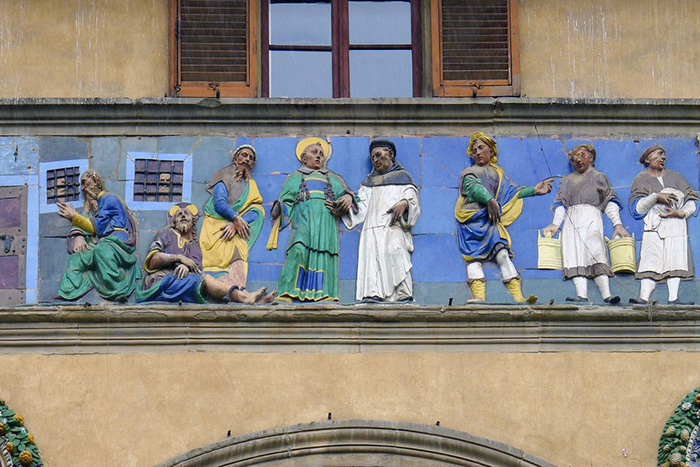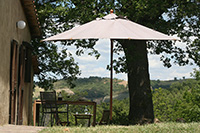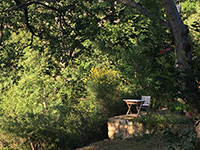| |
|
|
Pistoia, Ospedale del Ceppo [4]
|
History
According to tradition, the Ospedale was founded in 1277 by the company of Santa Maria or "del Ceppo dei poveri" ("The offering trunk of the poor").[0] In 1345 documents mention ongoing works for a new cloister, oratory and domus (residence for women). It became the main city's hospital after the donations received in the wake of the Black Death of 1348. Initially given to the cathedral chapter, from 1350 the commune of Pistoia tried to absorb direction of the company. After the conquest of Pistoia by the Republic of Florence (1401), the Florentines officially confirmed the lay status of the hospital.
In 1456 the hospital administrators commissioned the Florentine architect Michelozzo di Bartolomeo a restoration of the building. The election of the spedalingo (rector) was often contended between the noble Pistoiese families, sometimes causing popular turmoil such as in 1498. In 1494 the Compagnia del Ceppo was expelled in 1494, the hospital administrated by the communal priori. In 1501 the hospital was submitted to the Hospital of Santa Maria Nuova in Florence; the Florentine spedalingo, Leonardo Buonafede, ordered in this period the realization of the frieze which is now the main feature of the monumental façade.
In 1784 Grand Duke Pietro Leopoldo of Tuscany aggregated the hospital to a new entity including the other Pistoiese hospital of San Gregorio, the Spedali Riuniti di Pistoia, the spedalingo returning to be a Pistoiese.
|
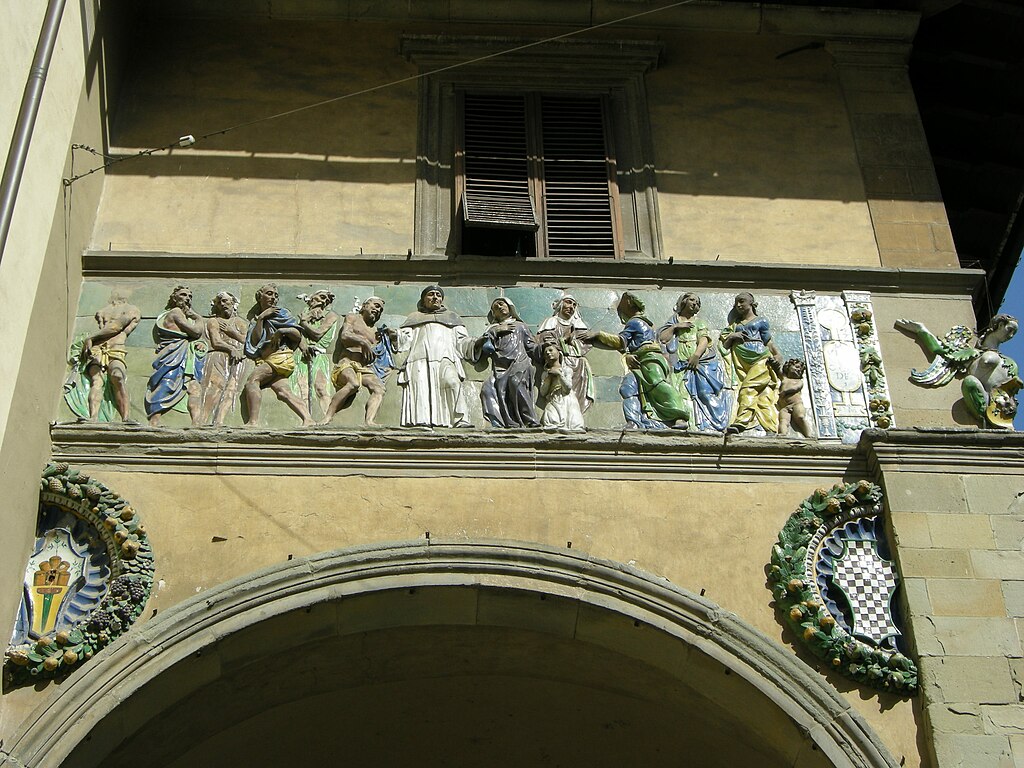
|
Pistoia, Ospedale del Ceppo, detail of the frieze and the tondoes [3]
|
Description
|
|
|
The current complex is the result of a series of additions and restorations of the original 13th-century edifice, which corresponds to today's corsia di Sant'Atto, a large ward with big windows now existing in a 16th-century renovation. In the 15th century the wing and the current façade were added, with the Renaissance arcaded loggia built in 1502, and inspired to the Ospedale degli Innocenti at Florence. The loggia is decorated by a ceramic glaze frieze esecuted from 1525 by Santi Buglioni: it portrays the seven works of mercy, mixed with scenes of the Virtues. A panel was replaced in 1586 by a new one, not in ceramic glaze.
Also from 1525 are the tondoes by Giovanni della Robbia, depicting the Annunciation, the Glory of the Virgin, the Visitation and the Medici coat of arms.
The corsia di San Leopoldo ("Ward of St. Leopold"), now the seat of the Pistoia Medical Academy, was originally intended for the contagious patients.
Images Ospedale del Ceppo
|
|
Giovanni della Robbiworkshop, Care of Sick, 1525-8, façade, Ospedale del Ceppo, Pistoia [3]
|
Medical practitioners are assigned pride of place in the few surviving contemporary representations of Renaissance hospital wards. The panel of the Care of the Sick is given particular prominence by Giovanni di Andrea della Robbia's workshop in the frieze The Seven Works of Mercy for the façade of the Ospedale del Ceppo in Pistoia.
This scene shows the practice of both internal and external medicine by portraying the visits of two medical experts. The physician on the left concentrates seriously as he listens to the pulse of an elderly patient whose gaunt features and open mouth suggest he is in some pain, while his assistant inspects a Jordan flask containing the patient's urine, the other major form of diagnosis. On the other side of the panel a surgeon examines the head or a patient in bed. In contrast to the old man being examined by the physician, this man is young and was probably wounded in a street brawl. Head fractures were among the most common conditions treated. [5]
|
 |
|
 |
Pistoia, Ospedale del Ceppo, detail of the frieze and the tondoes [2]
|
|
|
|
|
|
|
Pistoia, Ospedale del Ceppo, detail of the frieze and the tondoes [2]
|
|
|
|
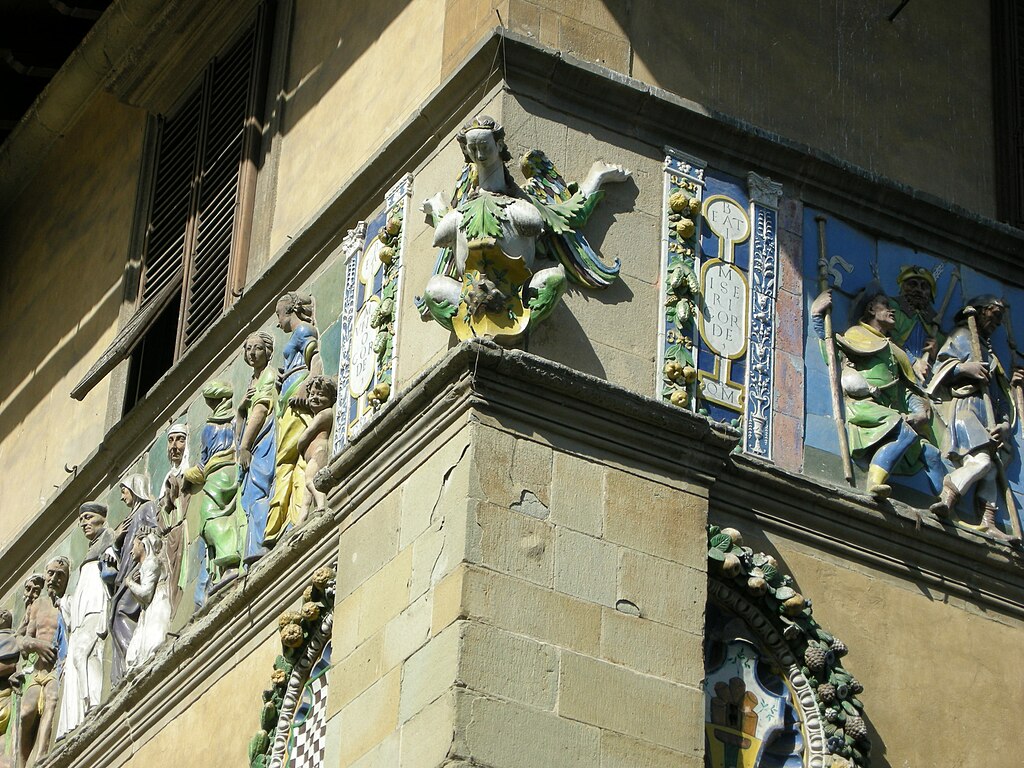 |
Pistoia, Ospedale del Ceppo, detail of the frieze and the tondoes [3]
|
 |
Pistoia, Ospedale del Ceppo, detail of the frieze and the tondoes [2]
|
|
|
|
|
|
|
 |
Pistoia, Ospedale del Ceppo, detail of the frieze and the tondoes [2]
|
|
|
|
 |
Pistoia, Ospedale del Ceppo, detail of the frieze and the tondoes [2]
|
|
|
|
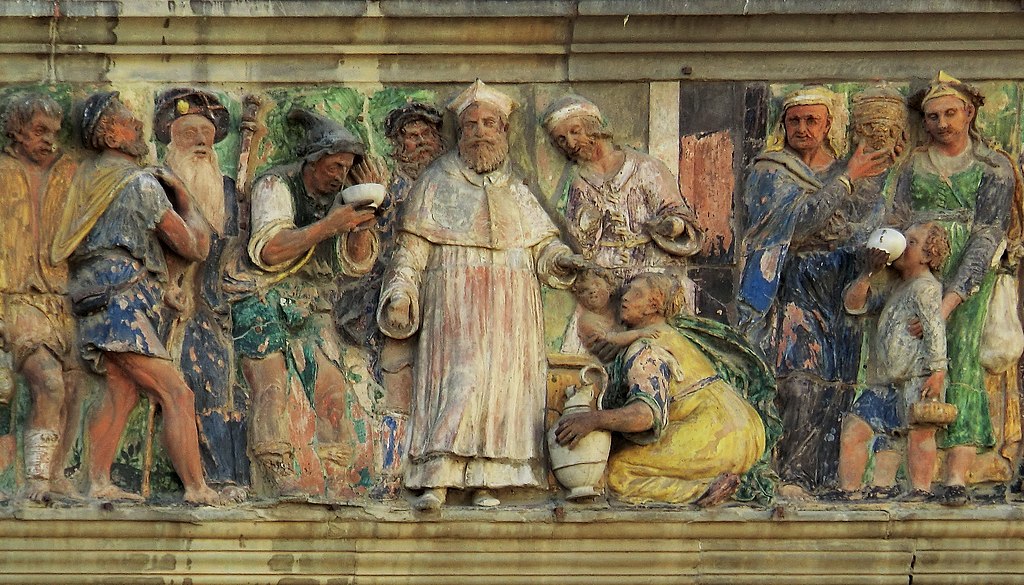 |
Pistoia, Ospedale del Ceppo, detail of the frieze and the tondoes [2]
|
|
|
|
 |
Pistoia, Ospedale del Ceppo, detail of the frieze and the tondoes [2]
|
|
|
|
 |
Pistoia, Ospedale del Ceppo, detail of the frieze and the tondoes [2]
|
 |
Pistoia, Ospedale del Ceppo, detail of the frieze and the tondoes [2]
|
|
|
|
 |
Giovanni della Robbia, Pistoia, Ospedale del Ceppo [3]
|
|
|
|
|
|
|
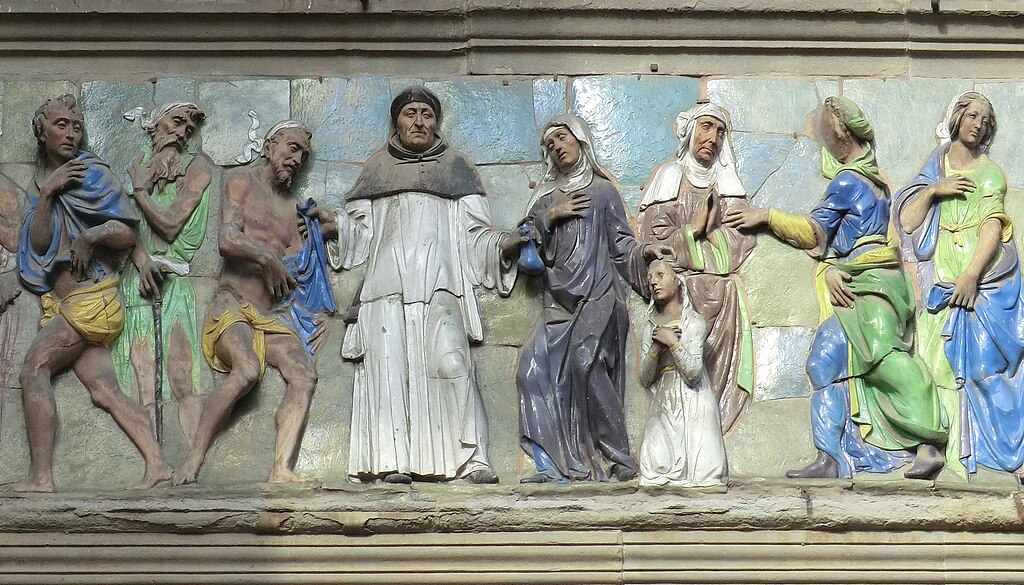 |
Pistoia, Ospedale del Ceppo, detail of the frieze and the tondoes [2]
|
|
|
|
| |

|
Pistoia, Ospedale del Ceppo [3]
|
 |
Pistoia, Ospedale del Ceppo [3]
|
|
|
|
 |
Pistoia, Ospedale del Ceppo, detail of the frieze and the tondoes [3]
|
Giovanni della Robbia, son of Andrea della Robbia, worked in the hospital of the Ceppo in Pistoia in the 1520s in collaboration with Santi Buglioni, nephew and collaborator of Benedetto Buglioni. Santi Buglioni produced there the frieze that runs along the entire length of the loggia of the hospital, representing the Seven Acts of Mercy, while Giovanni della Robbia executed the tondoes on the façade depicting the Annunciation, the Virgin in Glory, the Visitation, and the Medici coat of arms.
|
 |
Pistoia, Ospedale del Ceppo, Giovanni della Robbia, Visitation, c. 1525, Glazed terracotta, Ospedale del Ceppo, Pistoia[2]
|
|
|
|
 |
Pistoia, Ospedale del Ceppo Giovanni della Robbia, Virgin in Glory, c. 1525, Glazed terracotta, Ospedale del Ceppo, Pistoia[2]
|
|
|
|
 |
Pistoia, Ospedale del Ceppo Giovanni della Robbia,Annunciation, c. 1525, Glazed terracotta, Ospedale del Ceppo, Pistoia[2]
|
|
|
|
|
|
| |
|

[0] Con il termine 'Ceppo' si indicava nell'antichità il tronco di legno cavo in cui venivano raccolte le offerte destinate agli indigenti" ("The term ceppo (cfLatin cippus) indicated in times past the hollowed tree trunk in which were collected offerings intended for the poverty-stricken") (Il Ceppo dei Poveri di Prato).
Source: Giovanni Della Robbia and Santi Buglioni, creators of one of the most prestigious symbols of Pistoia | www.naturartpistoia.it
[1] Questo file è licenziato in base ai termini della licenza Creative Commons Attribuzione 4.0 Internazionale | Fotografia Alinari | This file comes from Wellcome Images, a website operated by Wellcome Trust, a global charitable foundation based in the United Kingdom. Refer to Wellcome blog post (archive).
[2] Photos made by Mattana
[3] Photo made bySailko
[4] Source: Renzo Dionigi on www.flickr.com
[5] John Henderson; The Renaissance Hospital: Healing the Body and Healing the Soul. New Haven, Connecticut, and London, Yale University Press, 2006, pp. 226-227
Bibliography
|

Allan Marquand, Unpublished Documents Relating to the Ceppo Hospital at Pistoia
American Journal of Archaeology
Vol. 22, No. 4 (Oct. - Dec., 1918), pp. 361-377
Published by: Archaeological Institute of America
John Henderson; The Renaissance Hospital: Healing the Body and Healing the Soul. New Haven, Connecticut, and London, Yale University Press, 2006
|
This article incorporates material from the Wikipedia articles Ospedale del Ceppo published under the GNU Free Documentation License.
Wikimedia Commons contiene immagini o altri file su Ospedale del Ceppo
|

|
| |
|
|
|
|
|
Podere Santa Pia |
|
Podere Santa Pia, appartment terrace |
|
Podere Santa Pia, secluded corners for writers or readers
|
| |
|
|
|
|
| |
|
|
|
|
| |
|
|
|
|

|
Podere Santa Pia.The valleys beyond Monte Labbro and Podere Santa Pia, a perfect landscape made of enchanting hillsides, oak woods, olive groves, vineyards and small villages.
Podere Santa Pia is situated just outside Castiglioncello Bandini, a small borgo between Arcidosso and Cinigiano
|
|
|
![]()
![]()
![]()
![]()
![]()

